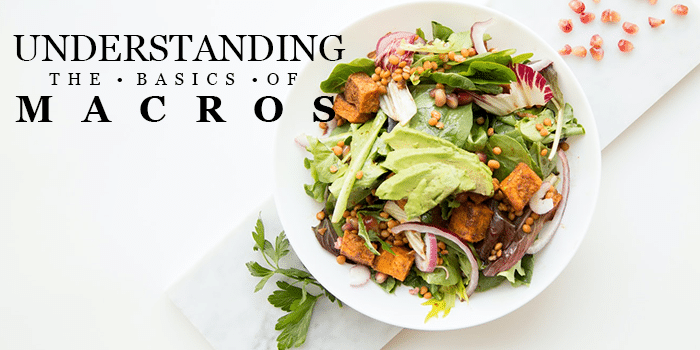 5-star Fitness
5-star Fitness
 5-star Fitness
5-star Fitness

In order to build a healthy, balanced plate, you need to understand the basics of macros. Once you understand the basics of macros, not only will you be able to build a balanced plate for every meal and snack, you’ll be able to manipulate any meals you eat out of your home to be as close to balanced and healthy as possible!
Before we get into the basics of macros, let’s review some balanced plate guidelines:
•Macros, or Macronutrients, are the nutrients our bodies need in large amounts: Protein, Healthy Fats, and Carbohydrates. (You could even consider water the fourth macro as it is so important!)
•A healthy, balanced plate will incorporate all macros in the proper quantities, and be high in quality.
•Carbs contain 4 cal per gram
•Fiber is essential to balance blood sugar levels, promote regularity, and keep your gut happy. Fiber is part of the carbohydrate family. Click here to learn more about the importance of fiber.
•A balanced plate is essential in order to maintain healthy blood sugar and energy levels, muscle mass, and to support healthy and efficient metabolism.
The Basics of Macros: Protein
•Protein is important for building, maintaining, and repairing muscle cells in addition to many other important biological functions.
• 1/4 of your balanced plate should be composed of protein.
•Protein contains 4 calories per gram.
•Typical portion sizes range for 4-6oz, or roughly about the size and thickness of your palm. Your personal portion size will depend on your size, stature, body composition, and goals.
•Protein Examples: Eggs, chicken, turkey, meat, fish, dairy, nuts, seeds, beans, lentils, and legumes.
•Small amounts of protein can also be found in other foods, such as vegetables and whole grains.
The Basics of Macros: Healthy Fats
•Fats are important for joint lubrication, hormone synthesis, cell integrity, healthy HDL cholesterol levels, hair and skin, and to facilitate the absorption of many fat-soluble vitamins like vitamins A, D, E, and K (very often found in vegetables).
•Fats contain 9 calories per gram
•Fats should be included in every meal/snack, but you don’t need a lot to get all the incredible health results. Proper servings of fats range from 1-2 Tbsp in oils to 1/4 Cup in seeds. A general rule of thumb is just that, a thumb! A serving size should be no bigger than your thumb.
•Not all fats are created equal. Monounsaturated fats and Omega-3’s, and a small number of saturated fats are supportive of our health and longevity. Processed fats, such as trans fats and large amounts of Omega-6’s and saturated fats are damaging to our cells and cardiovascular system.
•Strictly avoid trans fats (hydrogenated and partially hydrogenated oils).
•Consume saturated fats and Omega-6 fats in moderation.
•Healthy Fat Examples: Extra Virgin Olive Oil, olives, avocado, avocado oil, cold-water fish, and seeds.
The Basics of Macros: Carbohydrates
•Carbs are the simplest form of energy to fuel all of our cells. The quality and quantity of the carbs we are are important for managing blood sugar, which impacts energy levels and weight management.
•Approximately 1/4 of your plate should be composed of complex, low-glycemic carbs.
•Carbohydrates contain 4 calories per gram.
•Complex carbs are digested more slowly (thanks to their fiber), therefore providing a steady supply of energy without a drastic spike in glucose (blood sugar) levels.
•Simple carbs are easy to digest and breakdown into glucose very quickly, which leads to spiking blood sugar levels.
•You should opt for complex carbs most of the time and think of simple carbs as an occasional treat.
•Example of simple carbs (carbs you should eat very sparingly): simple sugars (candy, cakes, cookies), processed grains (bread, pasta, crackers), and some starchy vegetables (potatoes, peas, corn).
•Examples of complex carbs (carbs you should eat most of the time): Whole grains, vegetables, fruits, and carbs from beans, lentils, and legumes.
•Choose whole and unprocessed or minimally processed grains that are high in fiber and low-glycemic fruits and starchy vegetables.
The Basics of Macros: Vegetables
•Vegetables are important for their high vitamin, mineral, fiber, and enzyme content. They are low in calories, therefore we can and should consume a large amount of them daily.
• 1/2 of your plate should be vegetables at lunch and dinner, even breakfast!
•Choose a variety of vegetables. Aim for multiple colors throughout the day and week. Different colors represent different nutrients!
The Basics of Macros: Water
•Up to 60% of the human body is made up of water! The brain and heart are composed of 73% water, and the lungs are about 83% water. The skin contains 64% water, muscles and kidneys are 79% water, and the bones even contain 31% water.
•Water is important for our body’s natural detoxification process. Be sure to drink at least half your body weight in ounces daily, more if you are active or the weather if particularly hot.
The Basics of Macros: Important Guidelines
•Sodium: The American Heart Association recommends no more than 2,300 milligrams (mg) per day, and moving towards an ideal limit of no more than 1,500 mg per day for those with hypertension or at risk for hypertension.
•Added Sugar: The American Diabetes Association recommends no more than 25 grams of sugar per day for females and 36 grams for males.